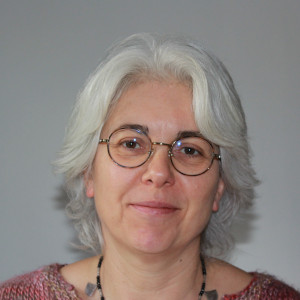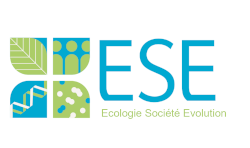
Florence Hulot
Position: Lecturer
Team: Ecological Processes and human Impact
Contact details:
Laboratoire Écologie, Société et Évolution – IDEEV
Bureau 2104 Bât. 680 – 12, route 128
91190 Gif Sur Yvette
Tel: +33 (0)1 69 15 56 82
Fax: –
Email: florence.hulot (at) universite-paris-saclay.fr
Research interests
My research subjects focus on the ecology of shallow lakes and wetlands and the role of abiotic conditions on their functioning. In particular, I study the effects of water column mixing, inputs of allochtonous organic matter and temperature changes on shallow lake and wetland dynamics.
Water column mixing depends on the wind regime through wave formation and, according to its intensity, it may suspend organic matter and nutriment that have settled in the benthic zone in shallow lakes. Freshwater organisms and their interactions may be affected by an increase of turbidity affecting photosynthesis for instance and resource inputs (nutrients, organic matter) in the pelagic zone. Inputs of allochtonous organic matter may also affect the dynamics of aquatic organism dynamics and food webs. Global changes may affect these abiotic conditions. Climate change can modify water column mixing through wind regime alteration. In addition, increased temperature stimulates water evaporation that changes water level and amplifies the effects of waves on resuspension. Changes in land use and rainfall patterns (intensity, frequency) also affect runoff and inputs of terrestrial organic matter in aquatic ecosystems. Understanding the effects of climate change changes on water column mixing and inputs of terrestrial organic matter in freshwater ecosystems in interaction with land use change are current challenges.
I use two complementary approaches: experiments in controlled systems and field studies. In my last projets, mesocosm experiments were realised in collaboration with the Planaqua platform in Cereep Ecotron – IledeFrance (https://www.cereep.bio.ens.psl.eu/). Field studies were conducted in Hwange National Park, Zimbabwe, in collaboration with the Hwange LTSER (Long-Term Socio-Ecological Research site) (https://www.za-hwange.cnrs.fr/?page_id=130&lang=fr).
Teaching
I teach for 3rd year student and graduate students in the master program Biodiversity Ecology and Evolution. I teach community ecology, functional ecology, aquatic ecology and ecotoxicology.
Pedagogy training
I also organize, in collaboration with colleagues from different department of the university, formation to pedagogy for doctoral students and newly recruited lecturers.
Responsabilities in teaching
I am co-responsible of the 3rd year program Organism Biology and Ecology (around 150 students), responsible of the teaching unit “Community and ecosystem ecology” and co-responsible of the teaching unit “Chemical risks and ecotoxicology”. In the master degree, I’m responsible of the 1st year internship and co-responsible of the teaching units “Professional integration” and “Ecological engineering”.
In the Biology Department, I’m correspondent for Ecology|Botany.
Career path
- 29/06/2015 : Habilitation à Diriger les Recherches in ecology, Paris-Sud University
- 01/09/2008 : Assistant Professor at Paris-Sud University, ESE Laboratory
- 01/09/2003 : Assistant Professor at P. et M. Curie University Diversité et fonctionnement des écosystèmes Laboratory (UMR 7625)
- 01/01/2002 – 31/08/2003: Post-doc at Amsterdam University (UvA). Superviser: Prof Jef Huisman – Marie Skłodowska-Curie fellowship
- 20/12/2001 : PhD in Ecologie, P. et M. Curie University. Superviser : Prof Michel Loreau, Ecologie et Evolution laboratory (UMR 7625)
- 06/1998 : Master thesis in Ecologie, P. et M. Curie University. Superviser : Prof Michel Loreau, Ecologie et Evolution laboratory (UMR 7625)
Administrative responsabilities
- 2012 – 2015: Member of the scientific council of the National Office of Water and Aquatic Environment (ONEMA)
- 2015 – : Member of the steering committee of the Hwange LTSER
- 2017 – : Member of the scientific council of the Water Agency Seine-Normandie
- 2018 – 2021: Appointed member of the CNECA (National committee for assistant and associate professors appointed by the Ministry of Agriculture)
- 2019 – 2020: Member of the scientific council of the Méréville Estate (property of Essonne Department)
Publications
Articles
- Hulot FD, Msiteli-Shumba S, Iung M, Noûs C, Thébault E. (2021) Spatiotemporal beta diversity of plankton species and their interactions in permanent and temporal waterholes in a semiarid savannah. Inland Waters 11: 508-521.
- Nélieu S., Lamy , Karolak S., Delarue G., Crouzet O., Barraud C., Bimbot M., Allaoui F., Hanot C., Delorme A., Lévi Y., Hulot FD, Baudry E. (2020) Impact of peri-urban landscape on the organic and mineral contamination of pond waters and related risk assessment. Environ Sci Pollut Res. DOI : 10.1007/s11356-020-10355-5
- Garnier, A., Hulot, F.D., Petchey O.L. (2020) Manipulated organism-environment feedback strength increases nonlinearity and apparent hysteresis of ecosystem response to environmental change. Ecology and Evolution 10:5527–5543. DOI: 10.1002/ece3.6294
- Hulot FD, Msiteli-Shumba S, Bonhomme M, Legendre S. (2020) Temporal changes in food web structure in semi-arid waterholes. Inland Waters. 10:542-550. 10.1080/20442041.2020.1754112
- Ferry N, Cordonnier M, Hulot FD, Dakwa F, Sebele L, Dray S, Fritz H, Valeix M. 2020. Heterogeneity of water physico-chemical characteristics in artificially pumped waterholes: do African herbivores drink at the same locations and does it lead to interference competition? Journal of Arid Environments. 173. 10.1016/j.jaridenv.2019.104014
- Hulot FD, Prijac A, Lefebvre J-P, Msiteli-Shumba S, Kativu S. 2019. Mega-herbivores subsidies in artificial pounds in Hwange National Park, Zimbabwe. Hydrobiologia. 837:161-175. 10.1007/s10750-019-3968-x
- Djebrani M, Jabbour F, Hulot FD, De Mazancourt P. 2019. Étude de l’interférence analytique de la biotine avec les immunoanalyses Siemens sur l’automate Dimension EXL® : impact sur les dosages de troponine I cardiaque et de vitamine D totale (D2+D3). Annales de Biologie Clinique. 77(6): 693-696. 10.1684/abc.2019.1503
- Hmimina, G., Hulot, F. D., Humbert, J.-F. and others. 2019. Linking phytoplankton pigment composition and optical properties: a framework for developing remote-sensing metrics for monitoring cyanobacteria. Water Res. DOI : 10.1016/j.watres.2018.09.055
- Msiteli-Shumba, S., Kativu, S., Utete, B., Makuwe, E., and Hulot, F. D. Driving factors of temporary and permanent shallow lakes in and around Hwange National Park, Zimbabwe. Water SA 44: 269-282.
- Msiteli-Shumba, S., Kativu, S., and Hulot, F. D. Influence of environmental variables on plankton community composition in permanent and temporal pools in and around Hwange National Park, Zimbabwe. Trans. Roy. Soc. S. Afr. 72 : 266-279.
- Hulot, F. D., Rossi, M., Verdier, B., Urban, J.-P., Blottière, L., Madricardo, F., and Decencière, B. 2017. Mesocosms with wavemakers: a new device to study the effects of water mixing on lake ecology. Oceanogr. Meth. 15: 154-165.
- Blottière, L., Jaffar Bandjee, M., Jacquet, S., Millot, A., and Hulot, F. D. Effect of water column mixing on freshwater ecosystems: a mesocosm experiment. Freshw. Biol. 62: 161-177.
- Prosnier, L., Loreau, M., and Hulot, F.D. Modeling the direct and indirect effects of copper on phytoplankton-zooplankton interactions. Aquat. Toxicol. 162: 73-81.
- Rochelle-Newall, E., Hulot, F.D., Janeau, J., and Merroune, A. 2014. CDOM fluorescence as a proxy of DOC concentration in natural waters: a comparison of four contrasting tropical systems. Monit. Assess. 186: 589-596.
- Hulot, F. D., Lacroix, G., and Loreau, M. 2014. Effects of nutrient enrichment and fish on size-based functional groups in pelagic food webs: a meta-analysis. Oikos 123: 1291-1300.
- Blottière, L., Rossi, M., Madricardo, F., and Hulot, F. D. 2014. Modelling the role of phosphorus, wind and warming on cyanobacterial (Microcystis aeruginosa) blooms in shallow lakes. Ecol. 7: 35-52.
- Muller, J. P., Laloi, D., Yéprémian, C., Bernard, C., and Hulot, F. D. 2013. To flee or not to flee: detection, avoidance and attraction of profitable resources by Daphnia magna studied with olfactometer. Limnol. 72: 464-472.
- Muller, J. P., Hauzy, C., and Hulot, F. D. Ingredients for protist coexistence: competition, endosymbiosis and a pinch of biochemical interactions. J. Anim. Ecol. 81: 222-232.
- Hulot, F. D., Carmignac, D., Legendre, S., Yéprémian, C., and Bernard, C. 2012. Effects of microcystin-producing and microcystin-free strains of Planktothrix agardhii on long-term population dynamics of Daphnia magna. Limnol. – Int. J. Lim. 48: 337-347.
- Hauzy, C., Gauduchon, M., Hulot, F. D., and Loreau, M. 2010. Density-dependant dispersal and relative dispersal affect the stability of predator-prey metacommunities. Theor. Biol. 266: 458-469.
- Hauzy, C., Hulot, F. D., Gins, A., and Loreau, M. 2007. Intra- and interspecific density-dependent dispersal in an aquatic prey-predator system. J. Anim. Ecol. 76: 552-558.
- Hulot, F. D., and Loreau, M. 2006. Nutrient-limited food webs with up to three trophic levels: feasibility, stability, assembly rules, and effects of nutrient enrichment. Popul. Biol. 69: 48-66.
- Hulot, F. D., and Huisman, J. 2004. Allelopathic interactions between phytoplankton: the roles of heterotrophic bacteria and mixing intensity. Oceanogr. 49: 1424-1434.
- Hulot, F. D., Morin, P. J., and Loreau, M. 2001. Interactions between algae and the microbial loop in experimental microcosms. Oikos 95: 231-238.
- Hulot, F. D., Lacroix, G., Lescher-Moutoué, F., and Loreau, M. 2000. Functional diversity governs ecosystem response to nutrient enrichment. Nature 405: 340-344.
Book chapters
- Hulot, F. D., and Cerqueira De Araujo, A. 2017. Effets des cyanotoxines sur les communautés zooplanctoniques en milieu lentique, p. 133-148. In Bernard, C., Mougin, C. and Pery, A. [eds.], Ecotoxicologie des communautés au fonctionnement des écosystèmes. ISTE.
- Scharler, U. M., D. Hulot, D. J. Baird, W. F. Cross, J. M. Culp, C. A. Layman, D. Raffaelli, M. Vos and K. O. Winemiller (2005). Central issues for aquatic food webs: from chemical cues to whole system responses. Dynamic Food Webs: Multispecies assemblages, ecosystem development, and environmental change. P. De Ruiter, V. Wolters and J. Moore. Amsterdam, Elsevier: 451-462.
- Huisman, J. and D. Hulot (2005). Population dynamics of harmful cyanobacteria. Factors affecting species composition. Harmful Cyanobacteria. J. Huisman, H. C. P. Matthijs and P. M. Visser, Springer: 143-176.
- Hooper, D., M. Solan, A. Symstad, S. M. Díaz, M. Gessner, N. Buchmann, V. Degrange, P. Grime, D. Hulot, F. Mermillod-Blondin, E. Spehn, J. Roy and L. van Peer (2002). Species diversity, functional diversity and ecosystem functioning. Biodiversity and ecosystem functioning: synthesis and perspectives. M. Loreau, S. Naeem and P. Inchausti: 195-208.
- Petchey, O. L., P. J. Morin, D. Hulot, M. Loreau, J. McGrady-Steed and S. Naeem (2002). Contributions of aquatic model systems to our understanding of biodiversity and ecosystem functioning. Biodiversity and ecosystem functioning: synthesis and perspectives. M. Loreau, S. Naeem and P. Inchausti. Oxford, Oxford University Press: 127-138.
